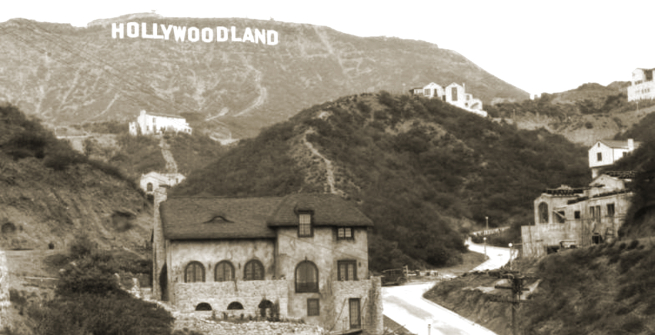"The lights of the city were an endlessly glittering sheet. Neon signs glowed and flashed. The languid ray of a searchlight prodded about among high faint clouds…The car went past the oil well that stands in the middle of La Cienega Boulevard, then turned off onto a quiet street fringed with palm trees…"—Raymond Chandler, Blackmailers Don’t Shoot
Setting is a crucial element in any novel or short story. What is a setting? The setting is so much more than geography. It includes climate, fashion, social norms, technology, transportation, and politics. The list goes on. All these added elements lend authenticity, nuance, and color to the story, drawing the reader into the world the author has created.
If Los Angeles is the setting of your story, how do you research the details that will bring the setting and your story to life? The Los Angeles Public Library has a number of terrific resources to help you set the scene.
Nothing beats the Photo Collection for visualizing what a street or neighborhood would have looked like. You can also answer questions such as, what did Pershing Square look like in 1930, how bad was the smog in downtown, and what were people wearing?

People sitting on benches in Pershing Square. Look at all those hats, [1930]. Security Pacific National Bank Collection
More than just telephone books, City Directories are goldmines of information. In addition to the usual name, address, and phone number, city directories often provide information such as an individual's profession, place of employment, and the name of their spouse.

Besides personal and professional information about residents, city directories also provide information about civic, social, and religious institutions, as well as all sorts of statistics about the number of miles of paved road, the number of books in the library, the salaries of civic employees and more.

The 1879-1880 City Directory even included current events of the past year.

Of course, searching the Los Angeles Times Historic Archives can be most useful. While you can look up specific events, locations, or people, it is worthwhile and fun to browse issues from the time period your work is set in. Even looking at ads can be helpful. In addition to the L.A. Times, the library provides access to several other local newspapers, including the Los Angeles Sentinel, the English/Japanese Rafu Shimpo, and the LA Weekly. If your fiction piece is set in the music scene of 1980s Los Angeles, searching the recently digitized LA Weekly turns up all kinds of information, such as what bands were in town and where they played, movie listings, apartment listings, and more.

Here's one resource you might not think of using–the Menu Collection. If your characters go to dine at the swank Hollywood nightclub Ciro's, what might they have ordered, and how much would it have cost?


The digitized Map Collection can answer questions like which red car line would your protagonist have taken to get from Hollywood to downtown L.A.

Another great map is the 1921 Baist Real Estate Atlas. Plate #2 identifies every building in downtown Los Angeles.

As senior librarian and award-winning author Mary McCoy says,
"Searching the California Index is like shopping at the world's best thrift store. Some days there's nothing there for you, but it's always worth popping your head in and poking around because whatever turns up is 100% guaranteed to be unexpected, and pointing towards resources you never would have thought to check."
The California Index is the Los Angeles Public Library's in-house index to parts of books, newspaper/magazine articles, photos, and vertical files related to people, places, and events important to Southern California history. There's information about neighborhoods, people, buildings, businesses, ethnic groups, and so much more.
Perhaps your story takes place during the Great Hiking Era in Los Angeles. In the California Index, you will find this map of the trails on Mt. Lowe (there were two pony trips daily) or this pamphlet for the alpine camp Switzer-land, both in the San Gabriel mountains above Pasadena.


Most of the above resources are accessible from home. Whether you are writing the next hard-boiled detective story or a satiric takedown of Hollywood, the Los Angeles Public Library can help you set the scene.


